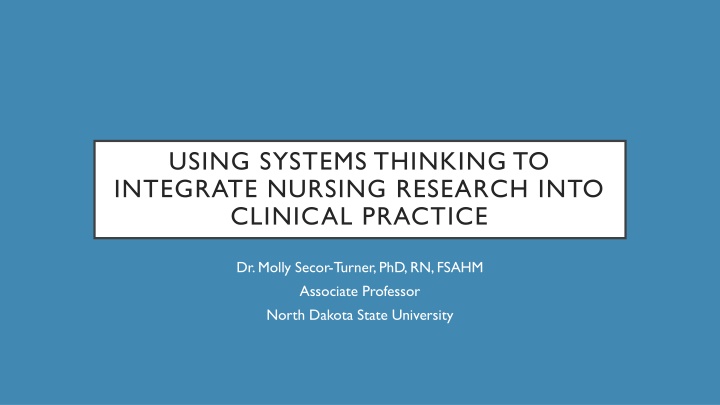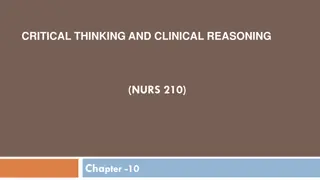Integrating Nursing Research into Clinical Practice with Systems Thinking
Dr. Molly Secor-Turner emphasizes the importance of evidence-based practice (EBP) in nursing. EBP, derived from rigorous research, leads to quality patient outcomes by aligning services with current knowledge. The process involves identifying problems, critiquing evidence, implementing recommendations, and evaluating changes. Establishing evidence-based nursing practice requires transforming research knowledge into clinical guidelines to improve healthcare quality. Three key aspects of quality in healthcare include targeted outcomes, consistency with research evidence, and aligning services with current knowledge to standardize practice. Nurses, as frontline healthcare workers, should lead in implementing EBP to ensure safe and effective care.
Download Presentation

Please find below an Image/Link to download the presentation.
The content on the website is provided AS IS for your information and personal use only. It may not be sold, licensed, or shared on other websites without obtaining consent from the author.If you encounter any issues during the download, it is possible that the publisher has removed the file from their server.
You are allowed to download the files provided on this website for personal or commercial use, subject to the condition that they are used lawfully. All files are the property of their respective owners.
The content on the website is provided AS IS for your information and personal use only. It may not be sold, licensed, or shared on other websites without obtaining consent from the author.
E N D
Presentation Transcript
USING SYSTEMS THINKING TO INTEGRATE NURSING RESEARCH INTO CLINICAL PRACTICE Dr. Molly Secor-Turner, PhD, RN, FSAHM Associate Professor North Dakota State University
NURSING PRACTICE Typically informed by: Tradition Personal choice Previous instruction Procedural guidelines may be outdated
EVIDENCE-BASED PRACTICE Key to quality patient outcomes Derived from rigorous research methods Fosters safe, effective and efficient healthcare Use to guide clinical decisions in clinical, hospital, and community settings Nurses should be leaders in implementing EBP as they frontline healthcare workers
DEFINING QUALITY HEALTHCARE Degree to which health services for individuals and populations increase the likelihood of desired health outcomes and are consistent with current professional knowledge IOM 1990, 2013, para 3
THREE ASPECTS OF QUALITY Services (interventions) Targeted health outcomes Consistency with current knowledge (research evidence) Goal: Align services with current knowledge, standardize practice to eliminate inconsistency
ESTABLISHING EVIDENCE BASED NURSING PRACTICE Transforming knowledge of research evidence into practice in the form of clinical practice guidelines Individual Microsystem System leaders Policies
EVIDENCE-BASED PRACTICE (EBP) The use of research data to guide clinical practice Rather than a single research study, EBP relies on data from multiple studies Research is used to develop evidence-based protocols Results in highest quality care for patients Evidence-based Practice Evidence-based Protocols Research Evidence
THE EBP PROCESS Identify a problem Critique the evidence Design and implement evidence-based recommendations Evaluate the change
EVIDENCE BASED PRACTICE Continuous problem-solving approach Integrates provider expertise with patient values and preferences Must take place within a culture and environment that fosters its success Context of caring and supportive ecosystem
SYSTEMS THINKING A way of thinking about and a language for describing and understanding the forces and interrelationships that shape the behavior of systems. Senge, 2006, p. 69
SYSTEMS THINKING Links personal behavior to the environmental context Continuum from individual level to broader internal and external environments Critical approach to patient safety and quality outcomes
HEALTHCARE OUTCOMES Involve interactions at the individual level that are influenced by broad systems level influences Represent complex, multilevel and multifunctional organizations of healthcare systems Nursing practice traditionally focused on individual level with less attention to systems level
SYSTEMS THINKING AND QUALITY HEALTH OUTCOMES Individual Level Care Systems Level Inputs Optimal Patient Care Patient centered care Teamwork/collaboration Evidence-based practice Safety Quality improvement
MOVING TO SYSTEMS LEVEL TO IMPROVE QUALITY OUTCOMES Personal effort/ individual care-----------------------------------------------Systems thinking/systems care Turn patient Post note above bed to remind others to turn patient Ask other nurses about ways to prevent ulcers Compare unit ulcer rates with benchmarks
IMPROVING PATIENT SAFETY TO IMPROVE PATIENT OUTCOMES High incidence of patient harm related to safety violations in low-income countries Harm to patients compounded by staff shortages, lack of resources, and under-developed professional education programs Systems thinking can address patient safety and therefore improve patient outcomes
PATIENT SAFETY Responsibility of an entire system vs. individuals Outcomes not the result of a single incident, rather the result of collection action of multiple microsystems May be related to: clinical practices equipment design maintenance and supply of equipment administrative procedures (e.g. staffing)
PATIENT SAFETY AND QUALITY OUTCOME RESPONSIBILITY Outcomes need to be thought of in the larger context of the entire healthcare system Considered the result of multiple inputs Shift responsibility to the system rather than the individual Reduces the concept of blame Contradicts the idea that patient death and suffering are unavoidable and/or normal
BARRIERS TO PATIENT SAFETY Lack of clinical and administrative protocols- and lack of implementation Lack of knowledge Lack of equipment Staffing shortages Poorly designed microsystems e.g. shift reports and communication structures
COMMUNICATION Critical component of creating a culture of safety and producing high quality patient outcomes Includes consideration of: Teamwork interdisciplinary and intradisciplinary communication Hierarchical dynamics response to communication and outcomes of communication Accountability vs. blame
CONCLUSIONS Nurses can play a critical role in producing quality health outcomes Nurses are often most proximal influence on patient safety Quality health outcomes depend on EBP and must take place within a culture of patient safety
CASE STUDY 1. 2. 3. Was this a preventable outcome? Why or why not? What are the patient level interventions that could have or should have been implemented? What are the nurse and provider level interventions that could have or should have been implemented? What are the systems level interventions that should have been implemented? How can evidence-based practice help? From your own experience and and practice settings, does this sound familiar? How would the staff at your workplace react to this situation? What are potential steps for action? How can we promote positive outcomes for our patients? 4. 5. 6. 7.























